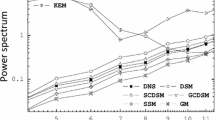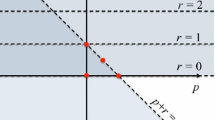Abstract
We studied the construction of subgrid-scale models for large-eddy simulation of incompressible turbulent flows, focusing on consistency with important mathematical and physical properties. In particular, we considered the symmetries of the Navier-Stokes equations, and the near-wall scaling and dissipation behavior of the turbulent stresses. After showing that existing models do not all satisfy the desired properties, we discussed a general class of subgrid-scale models based on the local filtered velocity gradient. We provided examples of models from this class that preserve several of the symmetries of the Navier-Stokes equations and exhibit the same near-wall scaling behavior as the turbulent stresses. Furthermore, these models are capable of describing nondissipative effects.
Access provided by CONRICYT-eBooks. Download conference paper PDF
Similar content being viewed by others
1 Introduction
It is well known that the governing equations of fluid dynamics, the Navier-Stokes equations, are form invariant under transformations like instantaneous rotations of the coordinate system and the Galilean transformation [13]. Such transformations, also referred to as symmetries, play an important physical role, because they make sure that the description of fluids is the same in all inertial frames of reference. Furthermore, they relate to conservation and scaling laws [14]. To ensure physical consistency it is desirable that the basic equations of large-eddy simulation, which are used to study the large-scale behavior of turbulent flows, satisfy the same principles. Speziale [17] was the first to emphasize the importance of Galilean invariance of subgrid-scale models for large-eddy simulation. Later, Oberlack [10] formulated requirements to make subgrid-scale models compatible with all the symmetries of the Navier-Stokes equations. Aside from preserving symmetries, it is desirable that subgrid-scale models share some basic properties with the turbulent stresses, such as the observed near-wall scaling [2] and the dissipation behavior [20]. In the current work we aim to construct subgrid-scale models that preserve these and other properties of the Navier-Stokes equations and the turbulent stresses.
In Sect. 2 we will outline several model requirements, after which, in Sect. 3, we analyze the properties of existing subgrid-scale models. Section 4 is devoted to the construction of new subgrid-scale models. Conclusions are presented in Sect. 5.
2 Model Constraints
In large-eddy simulation, the large-scale behavior of incompressible turbulent flows is described by the filtered Navier-Stokes equations, [15]
The turbulent stresses, \(\tau _{ij} = \overline{ u_i u_j } - \bar{ u }_i \bar{ u }_j\), are not solely expressed in terms of the filtered velocity field and therefore have to be modeled. In what follows we will discuss requirements that make sure that specific properties of the Navier-Stokes equations and the turbulent stresses are preserved in this modeling process.
2.1 Symmetry Requirements
We would like to ensure that the basic equations of large-eddy simulation, (1) with a subgrid-scale model in place of the turbulent stresses, admit the same symmetries as the unfiltered Navier-Stokes equations. Assuming that the filtering operation does not destroy symmetry properties, we need the following transformation behavior for the modeled subgrid-scale stresses, \(\tau ^{\mathrm {mod}}\) [10].
In (2) the hat indicates the time (S1) or pressure translation (S2), or the generalized Galilean transformation (S3). Conditions (3) and (4) ensure invariance under, respectively, instantaneous rotations and reflections (S4), and scaling transformation (S5), for an orthogonal matrix Q, and real a and b. Material frame-indifference in the limit of a two-component flow (S6) holds when (5) is satisfied for a constant-in-rate rotation about an axis perpendicular to the flow directions, described by R(t). In principle, (2) also has to hold under time reversal (S7) [10, 11, 14].
2.2 Near-Wall Scaling Requirements
Using numerical simulations, Chapman and Kuhn [2] have revealed the near-wall scaling behavior of the time-averaged turbulent stresses. We will require that the modeled stresses show the same asymptotic behavior, but then instantaneously (P1). Denoting the wall-normal distance by \(x_2\), we can express this property as
This ensures that, for instance, dissipative effects fall off quickly enough near walls.
2.3 Requirements Relating to the Production of Subgrid-Scale Kinetic Energy
We now focus on the production of subgrid-scale kinetic energy, also referred to as subgrid dissipation. Given the rate-of-strain tensor, see (12), it can be expressed as
Vreman’s Model Requirements Vreman [20] requires that the modeled production of subgrid-scale kinetic energy vanishes for flows for which the actual production is known to be zero. Preferably, also the converse is true. In summary, P2a,b:
These conditions are aimed at making sure that subgrid-scale models are neither overly (P2a), nor underly dissipative (P2b).
Nicoud et al. Model Requirements On the basis of physical grounds, Nicoud et al. [8] argue that certain flows cannot be maintained if energy is transported to subgrid scales. They therefore require that the modeled subgrid dissipation vanishes for all two-component flows (P3a) and for the pure axisymmetric strain (P3b). Note that these requirements are not compatible with the mathematical properties of the turbulent stresses as found by Vreman [20] and thus not with requirements P2a,b.
Consistency with the Second Law of Thermodynamics In turbulent flows, energy can be transported from large to small scales (forward scatter) and vice versa (backscatter). The second law of thermodynamics requires that the net transport of energy is of the former type, P4 [14]:
3 Analysis of Existing Subgrid-Scale Models
Before aiming to create subgrid-scale models that satisfy the constraints discussed in the previous section, we present a summary of the properties of several existing models in Table 1. A detailed discussion of results is omitted, but observe that the models do not necessarily satisfy all the desired properties. Because we assume the use of an isotropic filter, results relating to properties P2a,b differ slightly from those of Vreman [20].
4 Examples of Physically Consistent Subgrid-Scale Models
The subgrid-scale models of Sect. 3 are all based on the local filtered velocity gradient. Looking for models of a similar form to satisfy the constraints of Sect. 2, we take [4, 6, 12]
where the filtered rate-of-strain and rate-of-rotation tensors are given by
and, by isotropy (S4), the coefficients can depend only on the tensor invariants
We now aim to set this dependence in such a way that more constraints of Sect. 2 are fulfilled. Here it is important to keep in mind that the requirements of Nicoud et al. (P3a,b) are incompatible with those of Vreman (P2a,b). Furthermore, no two-dimensional material frame-indifferent quantities (S6) were found that satisfy both of Vreman’s requirements. This may point to a limitation of the model ansatz (11).
Combining compatible constraints, we obtain a class of what we will call physically consistent subgrid-scale models. The simplest models in this class with the proper near-wall scaling behavior (P1) have coefficients that depend only on the invariants of the rate-of-strain tensor, \(I_1\) and \(I_3\). For example (Ex. 1),
Here, \(\bar{\delta }\) denotes the filter length. Without additional procedures, the above model satisfies all the symmetries of the Navier-Stokes equations, apart from scale invariance (S5). Being orthogonal to each other, the three terms all have a different role. The first term on the right-hand side models the generalized subgrid-scale kinetic energy, the second describes dissipative processes, whereas the last term represents energy transport among large scales.
In view of the requirements of Nicoud et al. (P3a,b), a possibly attractive model of eddy viscosity type is based on the nonnegative quantity \(I_5 - \frac{ 1 }{ 2 } I_1 I_2\), Ex. 2:
It has the desired near-wall scaling behavior (P1) and it vanishes only in two-component flows, and in states of pure shear and pure rotation.
For comparison, the properties of these example models are summarized in Table 1.
5 Summary
We studied the construction of subgrid-scale models for large-eddy simulation of incompressible turbulent flows, aiming to preserve important mathematical and physical properties of the Navier-Stokes equations and the turbulent stresses. To this end, we first outlined model requirements coming from the symmetries of the Navier-Stokes equations, and from the near-wall scaling and dissipation behavior of the turbulent stresses. An analysis of existing subgrid-scale models showed that they do not all satisfy these requirements. We then considered a general class of subgrid-scale models based on the local filtered velocity gradient and provided examples of ‘physically consistent models’ that satisfy different combinations of model requirements. Although no models were obtained that exhibit all the desired properties, we believe the current reasoning has led to an interesting class of models, particularly because it allows for the description of nondissipative processes in turbulent flows.
References
Carati D, Winckelmans G, Jeanmart H (2001) J Fluid Mech 441:119. doi:10.1017/S0022112001004773
Chapman D, Kuhn G (1986) J Fluid Mech 170:265. doi:10.1017/S0022112086000885
Clark R, Ferziger J, Reynolds WC (1979) J Fluid Mech 91:1. doi:10.1017/S002211207900001X
Gatski T, Jongen T (2000) Progr Aerosp Sci 36:655. doi:10.1016/S0376-0421(00)00012-9
Germano M, Piomelli U, Moin P, Cabot W (1991) Phys Fluids A-Fluid 3:1760. doi:10.1063/1.857955
Lund T, Novikov E (1992) CTR Ann Res Briefs:27–43
Marstorp L, Brethouwer G, Grundestam O, Johansson A (2009) J Fluid Mech 639:403. doi:10.1017/S0022112009991054
Nicoud F, Baya H, Toda, Cabrit O, Bose S, Lee J (2011) Phys Fluids 23:085106. doi:10.1063/1.3623274
Nicoud F, Ducros F (1999) Flow Turbul Combust 62:183. doi:10.1023/A:1009995426001
Oberlack M (1997) Annual research briefs. Stanford University/NASA Ames, Center for Turbulence Research, pp 3–22
Oberlack M (2002) Theories of turbulence. In: Oberlack M, Busse F (eds)International centre for mechanical sciences, vol 442. Springer Vienna, 2002, pp 301–366. doi:10.1007/978-3-7091-2564-9
Pope S (1975) J Fluid Mech 72:331. doi:10.1017/S0022112075003382
Pope S (2011) Turbulent Flows. Cambridge University Press, Cambridge
Razafindralandy D, Hamdouni A, Oberlack M (2007) Eur J Mech B-Fluid 26:531. doi:10.1016/j.euromechflu.2006.10.003
Sagaut P (2006) Large Eddy simulation for incompressible flows, 3rd edn. Scientific computation. Springer, Berlin. doi:10.1007/b137536
Smagorinsky J (1963) Mon Weather Rev 91:99. doi:10.1175/1520-0493 091<0099:GCEWTP>2.3.CO;2
Speziale C (1985) J Fluid Mech 156:55. doi:10.1017/S0022112085001987
Trias FX, Folch D, Gorobets A, Oliva A (2015) Phys Fluids 27:065103. doi:10.1063/1.4921817
Verstappen R, Rozema W, Bae H (2014) Proceedings of the summer program. Center for Turbulence Research, Stanford University/NASA Ames, pp 417–426
Vreman A (2004) Phys Fluids 16:3670. doi:10.1063/1.1785131
Acknowledgements
The authors thankfully acknowledge Professor Martin Oberlack for stimulating discussions during several stages of this project. Theodore Drivas and Perry Johnson are thankfully acknowledged for their valuable comments and criticisms on a preliminary version of this paper. Portions of this research have been presented at the 15th European Turbulence Conference, August 25–28th, 2015, Delft, The Netherlands. This work is part of the research programme Free Competition in the Physical Sciences with project number 613.001.212, which is financed by the Netherlands Organisation for Scientific Research (NWO). MHS gratefully acknowledges support from the Institute for Pure and Applied Mathematics (Los Angeles) for visits to the “Mathematics of Turbulence” program during the fall of 2014.
Author information
Authors and Affiliations
Corresponding author
Editor information
Editors and Affiliations
Rights and permissions
Copyright information
© 2018 Springer International Publishing AG
About this paper
Cite this paper
Silvis, M.H., Verstappen, R. (2018). Constructing Physically Consistent Subgrid-Scale Models for Large-Eddy Simulation of Incompressible Turbulent Flows. In: Deville, M., et al. Turbulence and Interactions. TI 2015. Notes on Numerical Fluid Mechanics and Multidisciplinary Design, vol 135. Springer, Cham. https://doi.org/10.1007/978-3-319-60387-2_26
Download citation
DOI: https://doi.org/10.1007/978-3-319-60387-2_26
Published:
Publisher Name: Springer, Cham
Print ISBN: 978-3-319-60386-5
Online ISBN: 978-3-319-60387-2
eBook Packages: EngineeringEngineering (R0)




